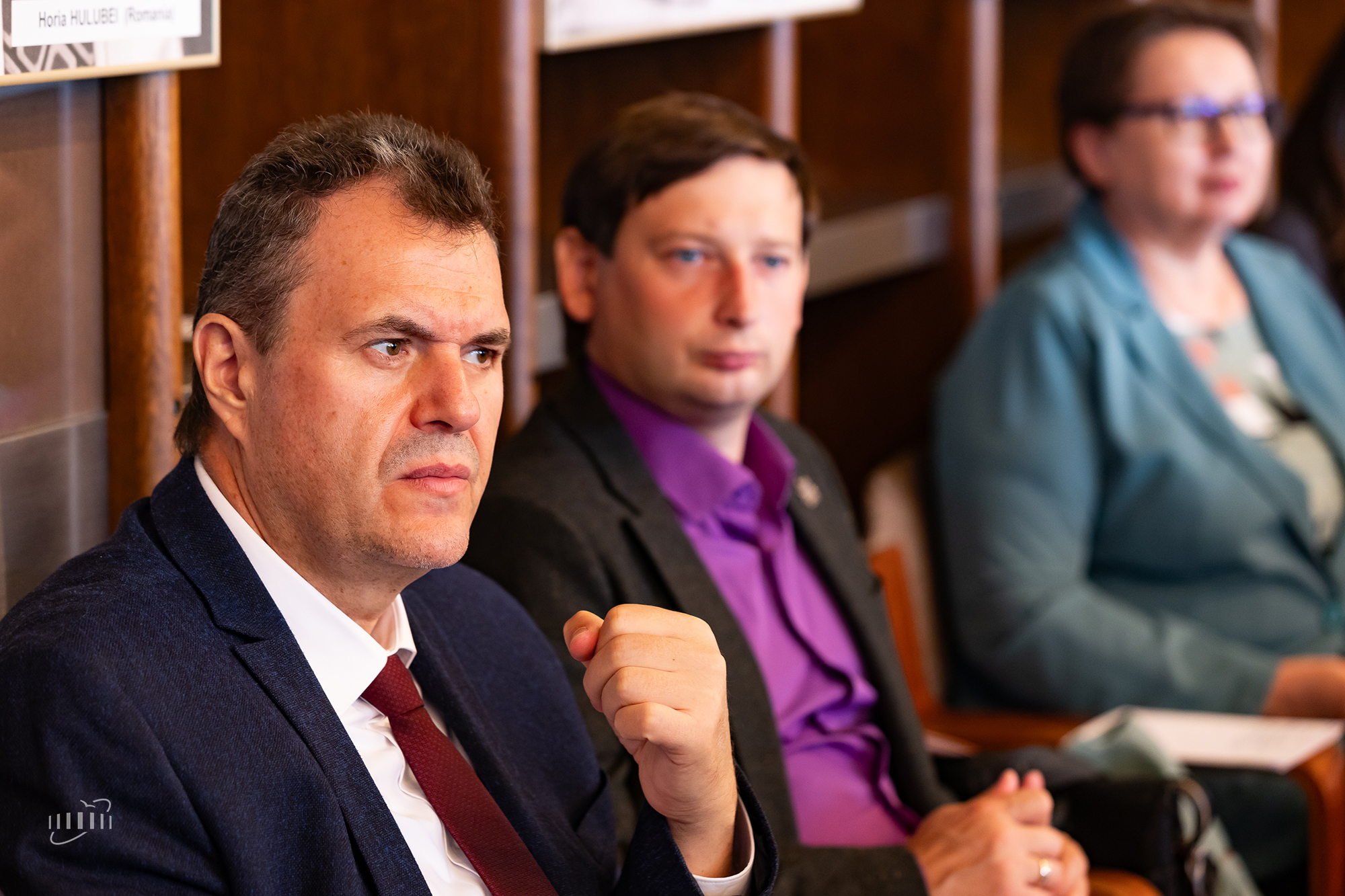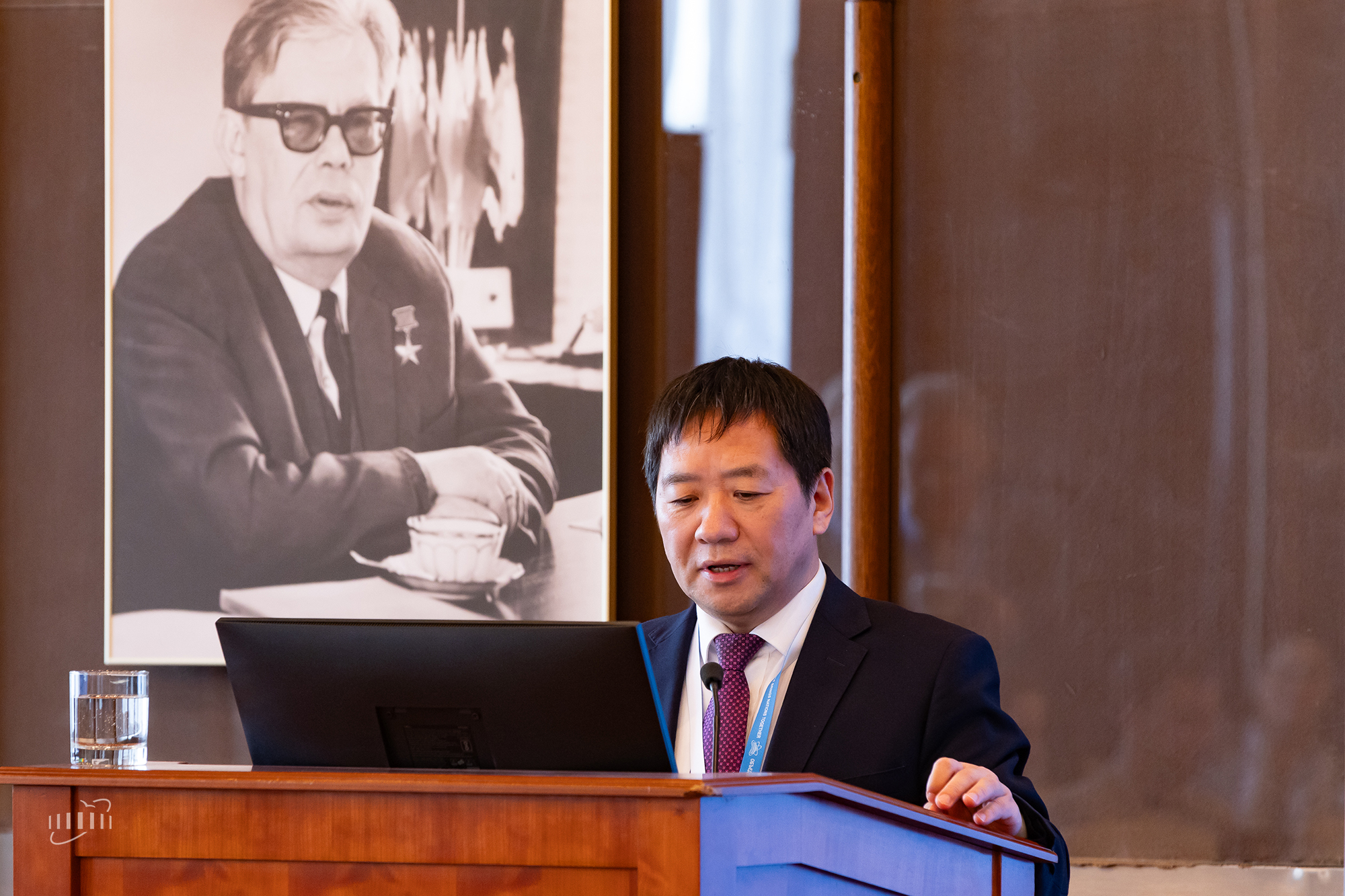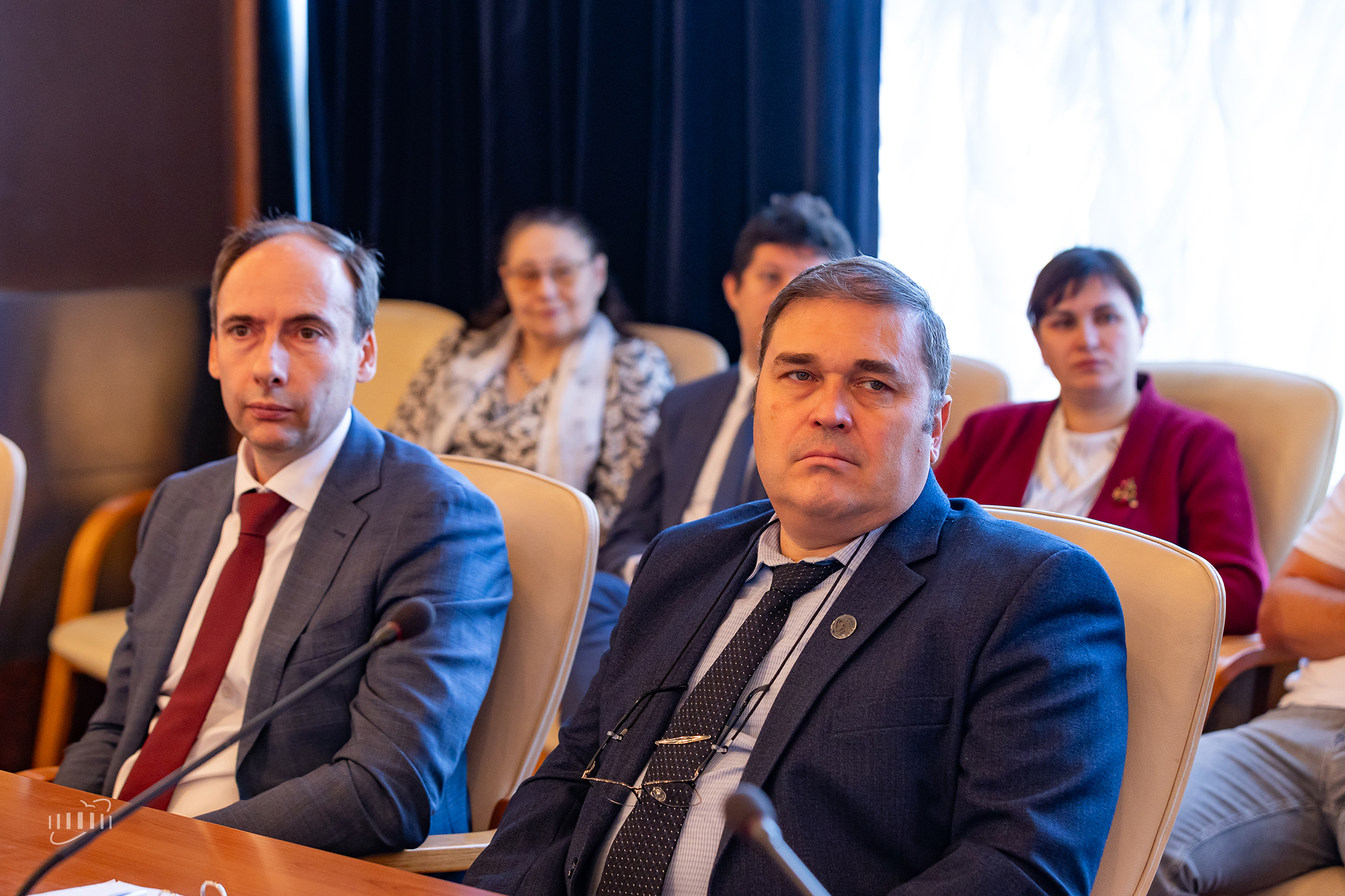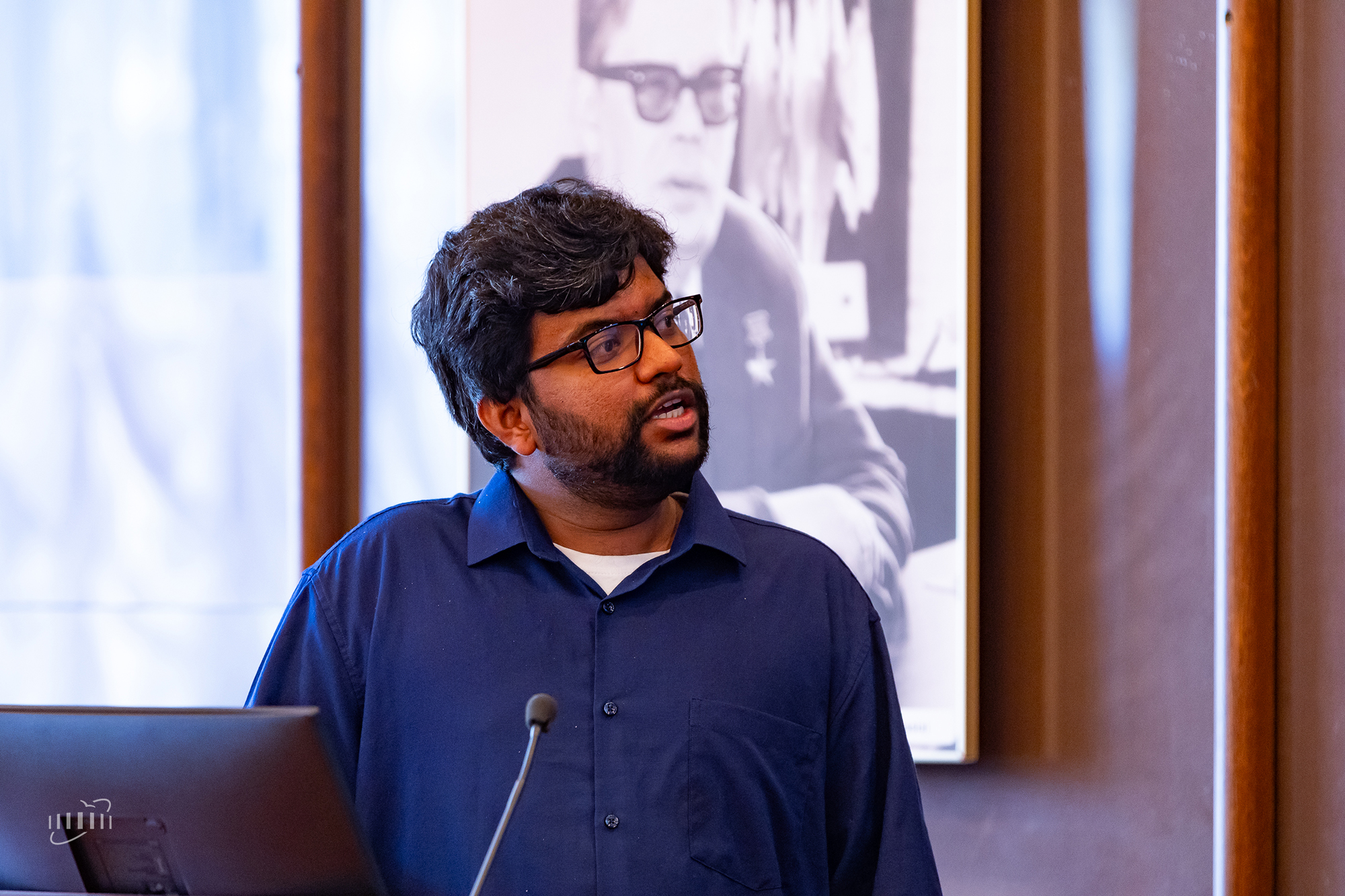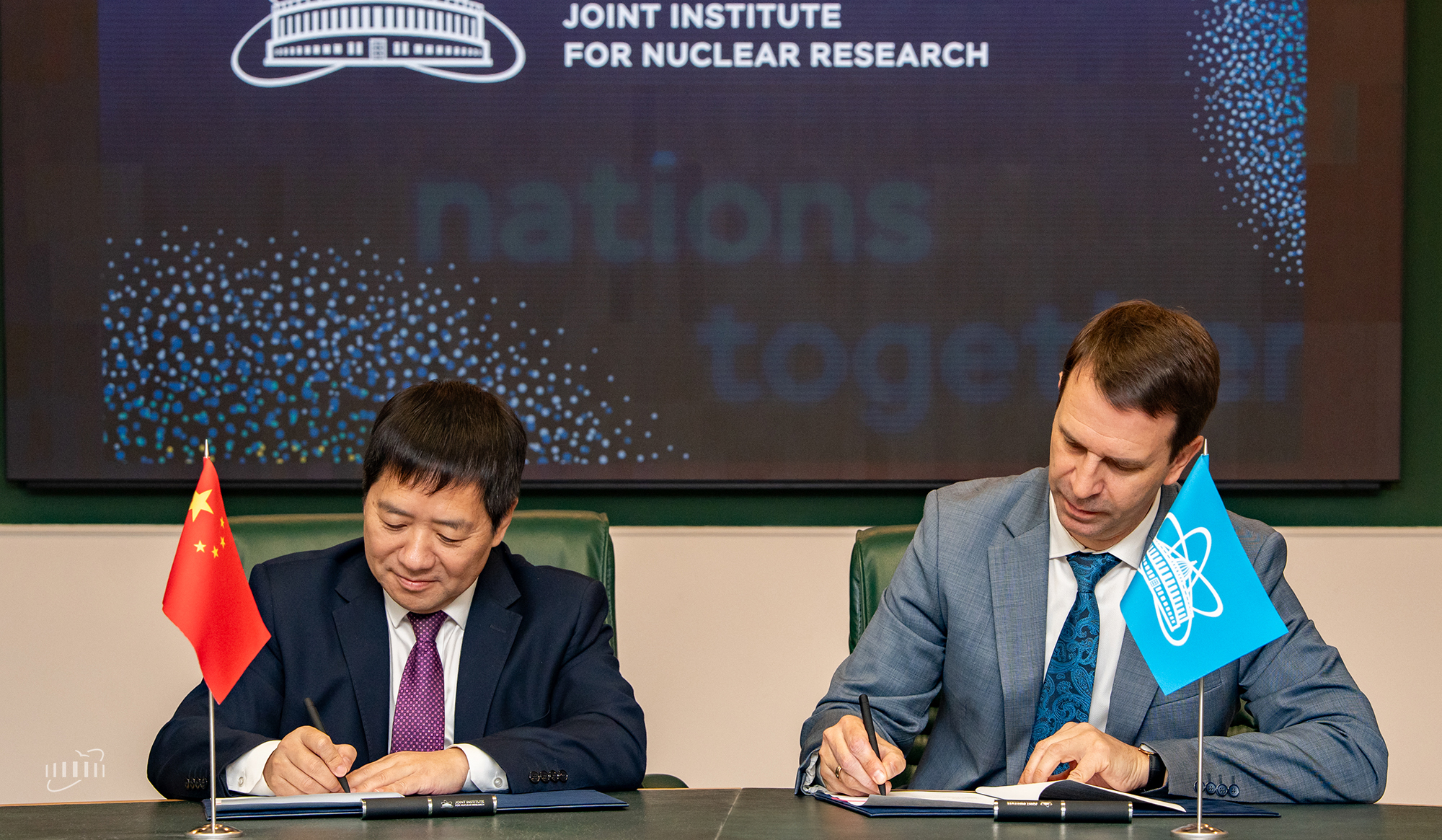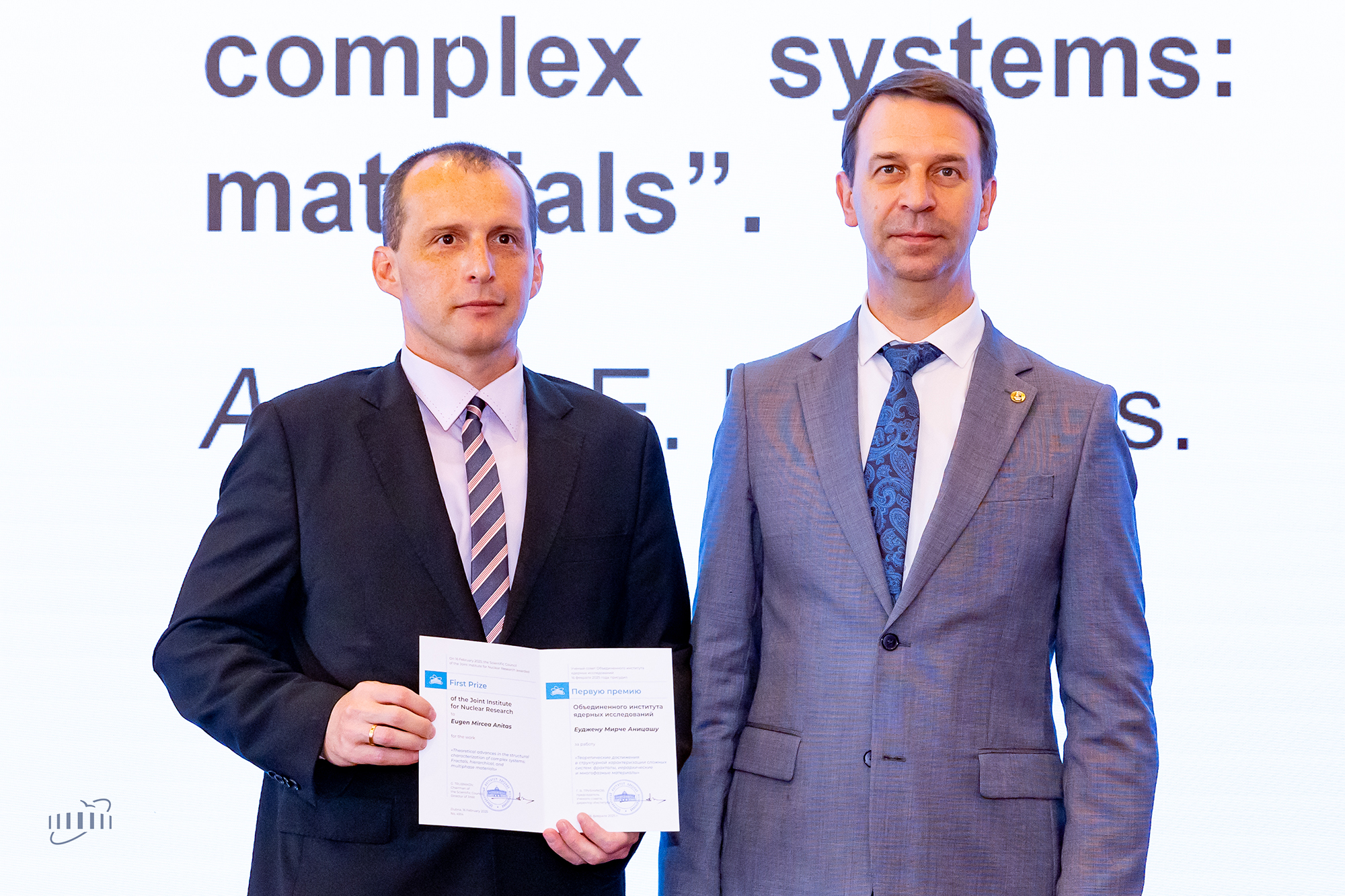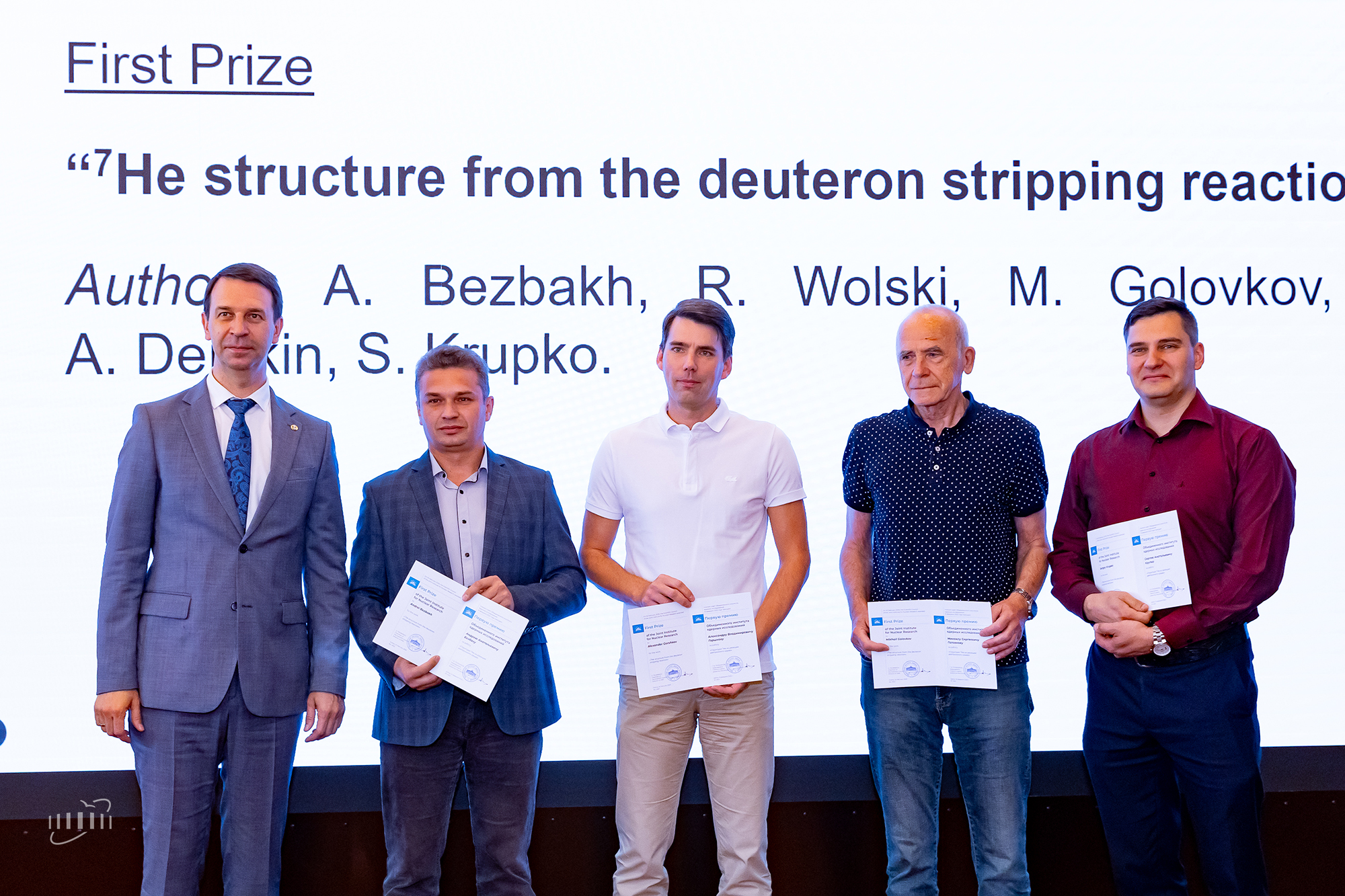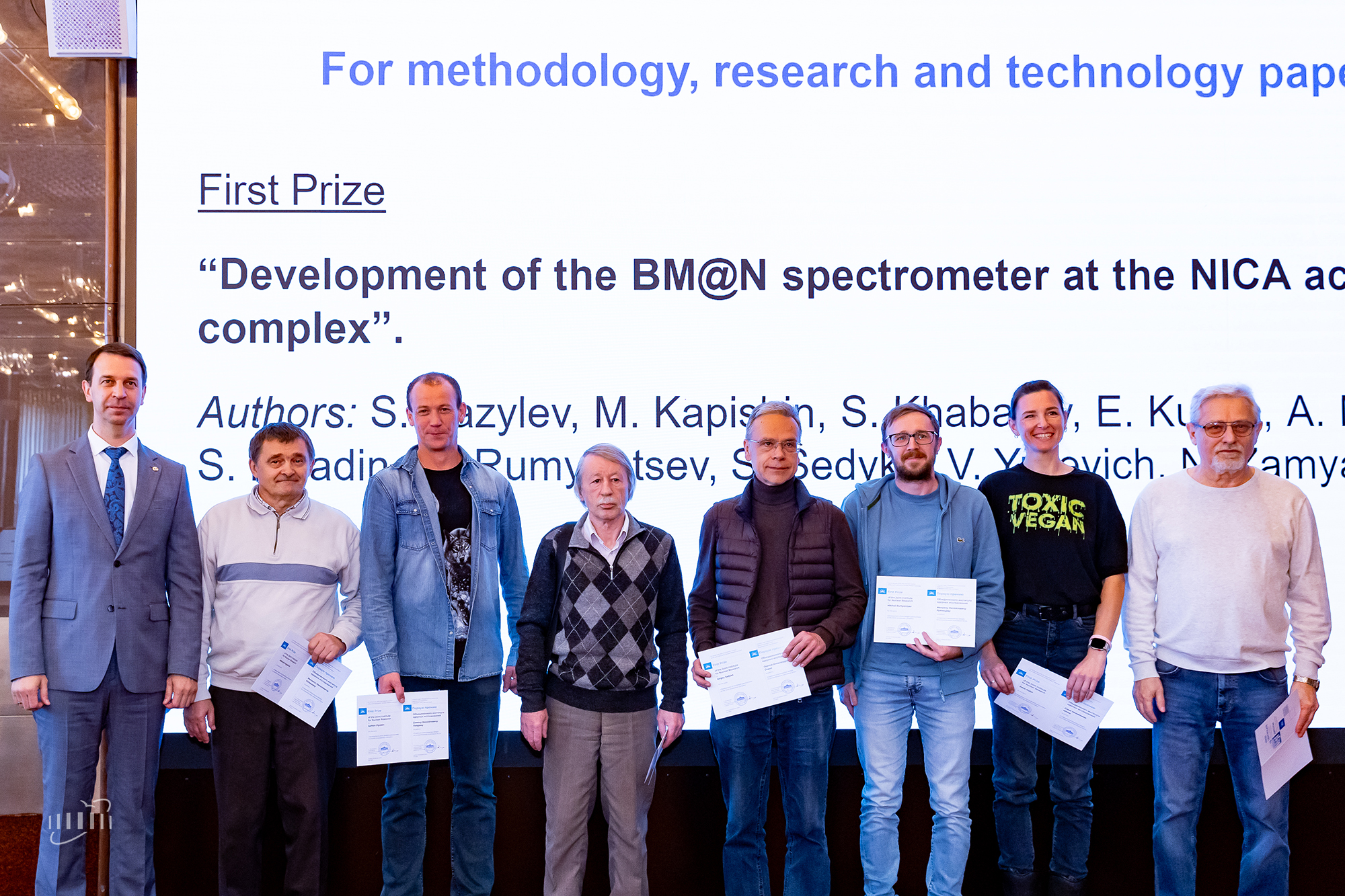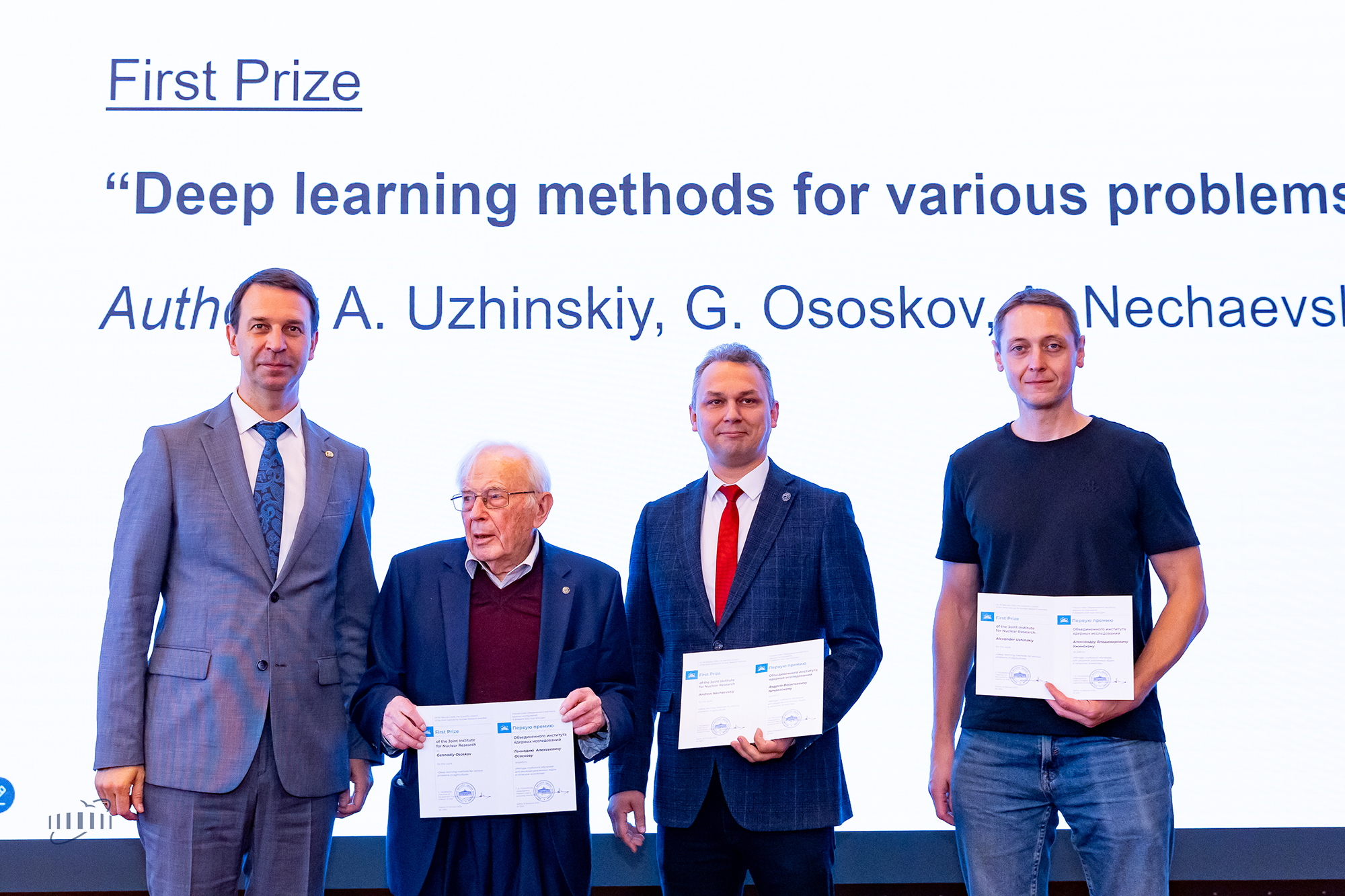Results of 138th session of JINR Scientific Council
News, 18 September 2025
On 15–16 September 2025, the 138th session of the Scientific Council of the Joint Institute for Nuclear Research took place at the International Conference Centre. The participants summarised the Institute’s scientific activities and discussed its latest achievements. At the session, the winners of the 2025 OGANESSON international prize were announced, new members of Programme Advisory Committees were approved, and deputy directors of the Flerov Laboratory of Nuclear Reactions were elected. The event finished with a ceremony to award leading JINR scientists and international partners.
JINR Director, Academician of the Russian Academy of Sciences Grigory Trubnikov started the session with a report highlighting the latest events at the Joint Institute. He spoke about the March 2025 CP session, the June meetings of the Programme Advisory Committees, and other meetings of the JINR Advisory Bodies.
Laboratory of Theoretical Physics
Among BLTP’s numerous scientific results, Grigory Trubnikov highlighted two works: “Manifestation of ternary clusterisation in binary spontaneous fission of 252Cf” and “Strong Kitaev interaction in BaCo2(AsO4)2“.
Laboratory of High Energy Physics
On 14 September 2025, helium cooling of the western half-ring of the collider began at the NICA Accelerator Complex. The eastern half-ring and two beam transport channels will be ready in the second half of October. “This is a very important part of the technical tests, a historic moment in the life of not only NICA and the laboratory, but the entire Institute,” Grigory Trubnikov emphasised. “In November, we plan to transport the first beam of heavy xenon ions from the Nuclotron to the collider”. After that, specialists will measure the luminosity at the beam crossing point of the MPD Detector. According to Grigory Trubnikov, the BM@N Experiment will begin taking data again in October.
The MPD solenoid was cooled down to operating temperatures (4.5 K), after which magnetic field measurements were carried out. 38 400 cells for MPD’s electromagnetic calorimeter, combined into 2400 modules, are being manufactured in Chinese universities and Russian scientific and industrial organizations. By December, 45 half-sectors of the calorimeter will be created. Half of the modules are ready, and the cooling system is being launched.
As part of the ARIADNA Collaboration, which is engaged in applied research at NICA, the new Station for Long-Term Exposure (SLTE) was prepared for launch, and a sample preparation laboratory was put into operation.
The SPD Collaboration is growing rapidly; it already includes more than four hundred participants. The collaboration is currently focusing on creating the detector’s supporting structure, engineering infrastructure, and detectors.
Laboratory of Nuclear Reactions
The preparation of experiments on the synthesis of elements 119 and 120 continues at FLNR. Together with the Institute of Modern Physics of the Chinese Academy of Sciences (IMP CAS), FLNR researchers conducted a series of experiments to study the chemical properties of copernicium (Cn) and flerovium (Fl).
The experimental halls of the DRIВS-III Accelerator Complex are being prepared for certification to ensure first-class radiation safety, and a new ion source is being assembled and launched. Commissioning of the U-400M Cyclotron continues. The main aim is to optimise various acceleration modes and obtain secondary beams. The modernisation of the radiochemical laboratory is nearing completion, and documents for its launch are being obtained. Construction work on the DC-140 Accelerator has been completed, and the assembly of its subsystems continues. Engineering systems are being assembled in the experimental hall of the U-400R Cyclotron, and two spectrometers are being designed for it.
Laboratory of Nuclear Problems
In March, a new cluster of the underwater Baikal-GVD Neutrino Telescope was installed in Lake Baikal, several strings were upgraded, and a new one was installed in cooperation with the Institute of High Energy Physics of the Chinese Academy of Sciences. The volume of the detector reached almost 0.7 km3, and it currently consists of about 4300 optical modules. Construction of a modern coastal computing centre began. It is planned to be completed within two years. DLNP and MLIT are developing the computer infrastructure of the centre.
The DANSS Experiment on the search for sterile neutrinos at the Kalinin Nuclear Power Plant has been collecting data on reactor antineutrinos for 9 years. Currently, the experiment has not revealed statistically significant evidence of the existence of sterile neutrinos, but the limits obtained for the mass of the lightest neutrino are the best in the world for a certain set of parameters. The detector will be upgraded next year.
Laboratory of Neutron Physics
In the first half of 2025, three cycles of operation of the IBR-2 Reactor were carried out. Summer preventive maintenance has been completed, and scheduled equipment repairs are underway. The reactor operates well after almost three years of shutdown and remains stable at a capacity of up to 1.5 MW. Further capacity increase requires additional research. Most of the experimental instruments are ready for measurements. Three of them are temporarily unavailable to users due to technical reasons. Physics experiments will start at the IBR-2 on 13 October, and four runs will take place until the end of the year. “By the end of August, 113 new users had registered in the user programme. In September, a new stage of submitting applications for participation in experiments began. We managed not only to retain, but also to attract new IBR-2 users,” the JINR Director said.
Large-scale studies of the angular distributions and cross sections of individual gamma rays induced by 14 MeV neutrons on a wide range of elements were carried out at FLNP as part of the TANGRA Project. Another FLNP experiment was devoted to the world’s first comprehensive structural studies of the k-carbide phase in Fe-Ga-Al alloys. Applied research on cultural heritage continues, as well as work on the use of neural networks for analysing neutron tomography data.
Laboratory of Information Technologies
In 2025, MLIT significantly upgraded its computing infrastructure, including the creation of 17 new servers for Tier-1 computing centres. This computing equipment is used for a wide range of international projects, including CMS and ATLAS at CERN, JUNO in China, as well as for simulations in the BM@N, MPD, and SPD Experiments. In 2025, the graphics processing unit of the Govorun Supercomputer was upgraded with two liquid-cooled nodes. As a result, the peak performance of the supercomputer reached 2.2 petaflops.
Laboratory of Radiation Biology
LRB scientists proposed a new approach to improving the biological effectiveness of therapeutic radionuclides. The results of experiments conducted jointly with the Federal Medical and Biological Agency of Russia will help reduce the number of therapy sessions in the future. LRB and VBLHEP researchers carried out a joint study to simulate the radiation exposure at the SIMBO and ISCRA Channels at the NICA Complex. LRB and Mongolian scientific centres presented the result of mathematical modelling of radiation-induced effects in the structures of the central nervous system after exposure to heavy charged particles.
Participation in external particle physics experiments
At the end of August, JUNO in China began taking data. “The contribution of the Joint Institute for Nuclear Research to the experiment is great. We participated in assembling and commissioning the tau detector and power supply systems for photomultipliers, designed and manufactured the Top Tracker muon veto system, and took part in the commissioning,” Grigory Trubnikov said.
JINR scientists continue to participate in the CMS and ATLAS Experiments at the Large Hadron Collider. The collaborations obtained new restrictions on the mass and cross-section of quantum black holes.
Educational activities and international cooperation
JINR conducts student internships involving new countries and institutions. More than 350 applications were submitted for the summer session, with 65 applications from 13 countries selected for participation. The Institute holds many student schools and conferences every year. The 13th JINR Information Centre opened in Rostov-on-Don, Russia. A master’s programme in applied mathematics and computer science opened at Dubna’s branch of Moscow State University. The head of the programme is MLIT Scientific Leader Vladimir Korenkov.
Representatives of the Bulgarian National Assembly, delegations from Serbia, the Academy of Sciences of Uzbekistan, the French Embassy in the Russian Federation, and heads of the National Research Foundation and the Department of Science, Technology and Innovation of South Africa visited JINR. JINR delegations made business trips to Belarus, Mongolia, Serbia, and Japan, where they met with heads of KEK and J-PARC laboratories.
Thanks to an agreement signed with the Brazilian Ministry of Science, Technology and Innovation in May, the JINR–Brazil Joint Coordinating Committee will be created in autumn. A cooperation agreement was signed with the University of Havana. Several joint projects with Mexico are starting this year as well.
In August, the JINR Director took part in a visit of the delegation of the Government of the Russian Federation to China. The Ministry of Science and Technology in Beijing supported the development and strengthening of cooperation between China and the Joint Institute for Nuclear Research. In addition, major scientific events were held in 2025 jointly with Cuba, Mongolia, South Africa, and Vietnam. The Days of the Joint Institute in Uzbekistan took place in April.
Other Institute’s news
“In 2024, about 930 researchers, engineers, and students from different countries visited JINR to conduct research or start a scientific career – a record number in recent years,” the Institute’s Director said. In 2023-2024, the publication activity of JINR employees increased. From January to August 2025, 11 dissertations, including four doctoral ones, were defended at the Dissertation Councils of the Joint Institute. This year, two issues of JINR’s new multidisciplinary journal, Natural Science Review, were published, and the next issue is already being prepared.
In June, the Institute established an interlaboratory science and technology advisory council, which goal is to supervise projects related to radiobiology, biophysics, and life sciences conducted by LRB, DLNP, FLNP, FLNR, and the ARIADNA Collaboration at NICA. The aim of the council is to develop a coordinated programme in this area, increase the efficiency of using research infrastructure, optimise interaction between laboratories, and involve researchers from scientific centres of Member and Partner States of the Joint Institute for Nuclear Research in cooperation. Based on the results of the council’s work, a programme committee on life sciences may be established at JINR in 2-3 years.
This year, for the first time, JINR selected proposals for implementation of innovations in research and development. Based on its results, five projects led by young researchers were selected.
A new JINR interactive web service, the Detector Centre, contains useful information about the Institute’s equipment, experience of working with components and materials, and the competencies of laboratory employees.
Work is underway on a new topic of the JINR Topical Plan, covering beam physics, R&D, and accelerator technologies. The key objectives will be to coordinate priorities and resources, as well as to promote close interlaboratory cooperation between JINR and research centres of the Member States.
Awards and titles
Two JINR Vice-Directors were awarded academic titles: Vladimir Kekelidze became an academician of the Russian Academy of Sciences, and Sergey Dmitriev became a RAS corresponding member. In addition, Sergey Dmitriev received the honorary state award of the Russian Federation, the Order of Friendship. JINR Scientific Leader Victor Matveev was awarded the Bogoliubov Gold Medal. Ana María Cetto, a member of the JINR Scientific Council, was honoured with the Tate Medal. Sergey Zavyalov, a young DLNP researcher, received a gold medal from RAS for developing software for the Baikal neutrino telescope. FLNP research groups were awarded medals at the Euroinvent-2025 international exhibition.
Grigory Trubnikov announced the winners of the 2025 OGANESSON Prize. Michel Spiro, Natalia Tarasova, Arutyun Avetisyan, and Alexei Semikhatov will receive the prize.
Following the speeches of the Chairs of the Programme Advisory Committees, Itzhak Tserruya, Valery Nesvizhevsky, and Dénes Lajos Nagy, JINR SC supported the recommendations adopted at the PACs for Particle Physics, Nuclear Physics, and Condensed Matter Physics in June 2025. In addition, the Scientific Council approved the structure of the Joint Institute’s Topical Plan for 2026.
At the meeting, Grigory Trubnikov proposed two candidates for the positions of new members of the Programme Advisory Committee for Particle Physics. According to the decision of the Scientific Council, Deputy Director of the RAS Institute for Nuclear Research Grigory Rubtsov (Russia) and Professor of the Alikhanyan National Science Laboratory Hamlet Mkrtchyan (Armenia) became PAC PP members.
As part of the scientific programme of the 138th session of the JINR Scientific Council, Director-General of the Institute of Plasma Physics (ASIPP) of the Chinese Academy of Sciences (CAS) Professor Yuntao Song presented a large-scale research programme and spoke about the prospects for the development of thermonuclear energy in China. He highlighted the latest achievements of the Experimental Advanced Superconducting Tokamak (EAST), including the record of maintaining high-temperature plasma for 1066 seconds, along with key experimental areas and plans for the future of scientific infrastructure at ASIPP. The strategic importance of developing the international cooperation of the CAS Institute of Plasma Physics with JINR and other world scientific centres received special attention.
Professor Khuyagbaatar Jadambaa made a presentation “How beautiful is the landscape of superheavy nuclei?”. He spoke in detail about the development of research on synthesis of new elements and presented the latest results achieved at the TASCA Gas-Filled Separator at the Helmholtz Centre for Heavy Ion Research (GSI, Germany), including the production of new isotopes of seaborgium (Sg) and rutherfordium (Rf). Professor Jadambaa stressed the importance of continued fruitful international cooperation in this field, emphasising the significant contribution of the Flerov Laboratory of Nuclear Reactions at JINR.
The first day’s programme included an election of deputy directors of the Laboratory of Nuclear Reactions. As a result, the Scientific Council approved Alexander Karpov and Grzegorz Kaminski for the positions until the end of Sergey Sidorchuk’s term as the FLNR Director.
On 16 September, young JINR scientists, whose papers were recommended by the Programme Advisory Committees, made presentations. A VBLHEP researcher Sudhir Rode spoke about the prospects for dilepton measurements in the MPD Experiment at the NICA Accelerator Complex. A BLTP junior researcher Mariia Mardyban presented the results of research on the low-energy spectra of nobelium isotopes. The talk by an FLNP junior researcher Bulat Bakirov was devoted to automated segmentation of pores and cracks using a Unet3+ convolutional neural network on neutron, synchrotron, and X-ray tomography data.
Grigory Trubnikov and Professor Song signed a Memorandum of Understanding between the Joint Institute for Nuclear Research and the Institute of Plasma Physics of the Chinese Academy of Sciences. The document provides for the expansion of cooperation in research and work on accelerators and tokamaks for the NICA (JINR) and EAST (ASIPP) Projects, along with the development of academic exchange.
On the second day of the 138th JINR SC session, the former President of the Egyptian Academy of Scientific Research and Technology, the first Plenipotentiary Representative of the Arab Republic of Egypt in JINR, Mahmoud Sakr, was awarded the title of Honorary Doctor of the Joint Institute for Nuclear Research. Grigory Trubnikov noted the significant contribution of the Egyptian researcher to the strengthening of fundamental science and the development of international scientific relations.
Expressing deep gratitude for the high academic rank, Mahmoud Sakr described the award not only as a historic moment for him personally, but as a reminder of the “great power of science” capable of “blurring borders and bringing nations closer together”. Emphasising the fact that Egypt is the only JINR Member State in the Middle East and Africa, he noted: “For us, this is not only a national achievement, but also a call for increased international participation in the activities of the Joint Institute. Let Egypt serve as a bridge that will bring new countries of our region into this large scientific family. Together we can serve nobly for the benefit of science, strengthen cooperation, and build a bright future for all humankind”.
Advisor to the Directorate of the Laboratory of Neutron Physics Marina Frontasyeva received the Dzhelepov Prize for her significant contribution to the development of the international programme for assessing air quality using neutron activation analysis methods. Under her leadership, dozens of scientists and young specialists of the Institute have been conducting a wide range of applied ecological studies in recent years.
In her acceptance speech, Marina Frontasyeva expressed hope that JINR would develop not only as an international centre for nuclear research, but as an institute of life sciences, and that her own studies would contribute to the popularisation of nuclear physics methods in ecology, medicine, and other applied fields for the benefit of humankind.
At the end of the public part of the meeting, Grigory Trubnikov and Chief Scientific Secretary of the Institute Sergey Nedelko presented diplomas to the 2024 JINR Prize winners. The awards were given for the best scientific works, including methodological and applied technical studies.
The session concluded with the adoption of the SC Resolution. The 139th session of the Scientific Council of the Joint Institute for Nuclear Research will take place in February 2026.








